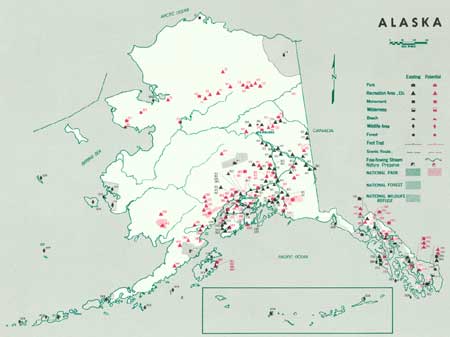.gif)
Parks for America
MENU
|
Parks for America
|

|

|
| A concentration of lakes, rivers, and mountains make the Wood-Tikchik region one of the finest potential recreational areas in Alaska. (ROGER ALLIN.) |
ALASKA
THE POPULATION of Alaska increased 75 per cent in the decade 1950-1960 to 226,200. Projections indicate it may reach 322,000 by 1976. Fifty-six percent of the population is located in the Anchorage and Fairbanks districts. Overall density is 37 persons for each 100 square miles.
Alaska's economy is largely dependent upon Federal defense spending. The recreation industry ranks behind fisheries and forest products with an expenditure of $29 million annually. Tourism has a tremendous potential as existing facilities are negligible, and the State's wildlife, fisheries, scenic, and wilderness resources are unsurpassed.
Much of the travel to Alaska is by air. Major air lines serve the principal cities, and from these certified carriers make accessible all parts of Alaska. In southeastern Alaska, where there is poor flying weather, access is by boat through protected waterways. To travel to Alaska by car it is necessary to traverse 1,200 miles of the graveled Alaska Highway through Canada. Roads are being built in Alaska, but for the present are not extensive.
Alaska has a variety of recreation resources. Southeastern Alaska is a mountainous archipelago with scenic glaciers, fords, forests, and high gradient streams. The entire region is wilderness except for occasional towns. Indian and Eskimo lore, Russian and gold rush historic sites, and commercial fishing activities are additional tourist attractions. Ipiutak and Iyatayet are prehistoric sites possessing exceptional value in commemorating the prehistory of the United States.
Interior Alaska is largely mountainous with broad-timbered valleys and numerous lakes. The glaciers, icefields, and mountains of the Alaskan, Chugach, and coastal ranges are unsurpassed. The interior is mostly wilderness. Hunting, fishing, and the observation of wildlife species are significant recreation assets.
The climate varies greatly. Southeastern Alaska has mild winters, cool summers, and heavy precipitation. The south-central region has ideal climate for winter sports and summer recreation. Interior Alaska has light precipitation, very cold winters, and warm summers. Recreation in the Arctic, where summers are cool and winters frigid, is only for the hardy outdoorsman.
EXISTING PUBLIC AREAS
NATIONAL: The National Park Service administers 1 national park and 3 national monuments with a total acreage of 6,911,251 acres and a 1960 attendance of 39,451. The Forest Service administers 2 national forests of 20,741,994 acres containing 39 developed recreation sites and 2 scenic areas. The Bureau of Sport Fisheries and Wildlife manages 18 wildlife ranges and refuges with a total of 18,984,535 acres. Ninety-eight percent of Alaska is publicly owned and administered.
STATE: The State administers 63 areas: 3 historical monuments, 1 scenic wayside, 8 picnic waysides, and 51 campground waysides, totaling 2,916 acres. These areas are used mainly by residents as base camps for use of adjacent recreation resources.
LOCAL: There are two local parks and one recreation area. Together they total 191 acres.
PRIVATE ENTERPRISE: In general, lodging accommodations and recreation facilities operated by private enterprise are relatively rustic. The development of additional and better facilities is desirable.
PARK AND RELATED NEEDS
There are sufficient outdoor recreation resources in Alaska to meet all present and future needs. Provision needs to be made now while Alaska is still essentially undeveloped for the protection of the best examples of major land forms in parks and nature preserves, the zoning of scenic routes, the establishment of public recreation areas, the preservation of scientific and historic monuments, and the designation and protection of free-flowing streams as well as development of recreation lands to improve the State's economy. There is need for high-quality developments to provide residents and the out-of-State visitors with adequate recreation facilities.
Potential State areas identified total 1,589,089 acres. Potential local acreage identified is 38,005 acres and is sufficient to meet foreseeable needs.

|
| Brown bears, catching salmon from McNeil River at Kamishak Bay, typify Alaska's vast wealth of wildlife resources. (U.S. FISH AND WILDLIFE SERVICE.) |
RECOMMENDATIONS
Existing recreation resources and many potential areas are shown on the accompanying tabulation and map. The following recommendations are made to help provide needed outdoor recreation opportunities for public enjoyment and use.
NATIONAL: Give further study to the proposals to establish the St. Elias-Wrangell Mountains and Lake Clark Pass National Parks. The Wood-Tikchik area, although tabulated as a potential State recreation area, is of possible national significance and might lend itself to joint Federal-State administration.
STATE: Enlarge the State park system to preserve valuable resources and provide recreation opportunities by the addition of 17 parks, 27 recreation areas, 3 scientific monuments, 2 historic monuments, and 1 nature preserve with further study of 4 other parks and 10 recreation areas. Designate and protect 12 scenic routes, 4 free-flowing streams, and 1 foot trail.
LOCAL: Establish 3 parks, 14 recreation areas, 1 beach, and 1 foot trail, and give further study to establishment of 2 recreation areas and 4 beaches.
Supporting recommendations include—
1. Emphasis on the acquisition of areas dedicated to preservation of natural resources.
2. Immediate establishment of additional camp grounds along the highway system and proposed ferry routes.
3. Enlargement of nine existing State campsites in critical locations by a total of approximately 3,000 acres.
4. Increased attention by Federal, State, local, and private agencies to the preservation, maintenance, and interpretation of historic and archeologic sites.
(Table omitted from online edition)

|
| (click on image for an enlargement in a new window) |
NEXT >>>
|
|
Last Modified: Mon, Sep 6 2004 10:00:00 pm PDT
parks_america/alaska.htm
 Top
Top